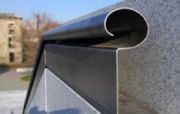 |
|
October 2015
|
Welcome to ‘Stainless Solutions’ from IMOA. Each month, we will cover a different stainless steel issue with tips on design and specification, and links to technical resources. This month we are discussing stainless selection in New York City, which is representative of many urban areas around the world. |
| Selecting Stainless Steel for New York’s Expanding Skyline |
|
New York’s construction industry is doing well and cranes are visible throughout Manhattan. Over 20 recent or current high profile projects are clad in Type 316 stainless steel, including high-rise offices, public and residential buildings. |
 |
Javitz Convention Center was expanded and wrapped in Type 316L stainless steel.
Credit N. Kinsman, IMOA |
Why is Type 316 stainless steel being selected for so many projects? New York is coastal and uses deicing salt. This corrosive combination is increasingly common globally. On average, 60% of the world’s population lives in coastal zones. Deicing use has been growing and about 70% of the US population lives in areas with at least some deicing salt use. Both need to be considered during material specification. Less corrosion resistant stainless steels like Type 304 will exhibit superficial corrosion staining in this environment and require regular cleaning to maintain a corrosion free appearance. |
 |
The 9/11 Memorial Museum has perforated Type 316 stainless steel sunscreens and is surrounded by Type 316L stainless steel clad high rise buildings.
Credit C. Houska, TMR Consulting |
IMOA’s site evaluation system takes both types of salt exposure, pollution, and other factors into consideration. We suggest IMOA’s deicing salt and coastal salt information resources and the recently revised Nickel Institute brochure, Guidelines for Corrosion Prevention to assist with site evaluation. |
 |
New York’s Four Freedoms Park used 2205 duplex stainless steel railings to take into account the risk of storm surge flooding.
Credit Custom Manufacturing & Polishing |
Like other coastal cities, New York increasingly faces flooding from storm surges. 2205 duplex stainless steel is substantially more corrosion resistant than Type 316L and higher in strength. It can withstand short-term immersion in salt or brackish water, as occurred at Four Freedoms Park during and after Hurricane Sandy, without surface staining. Many similar Type 316L applications were badly stained after the storm. See our duplex resources for more information.
|
| Stainless Solutions e-newsletter archive |
|
For previous issues or to subscibe to the e-newsletter, please visit the archive page. |
| Continuing Education – American Institute of Architects (AIA) |
|
IMOA is an AIA continuing education system approved provider with eight 1-hour programs that are registered for both live face-to-face and distance learning credit.
1. Stainless Steel Sustainable Design
2. Bioclimatic Design With Stainless Steel Weather Screens
3. Stainless Steel Structural Design
4. Stainless Steel Specification For Corrosive Applications
5. Deicing Salt: Stainless Steel Selection to Avoid Corrosion
6. Stainless Steel Finish Specification
7. Advanced Stainless Steel Specification and Problem Avoidance
8. Specification of Stainless Steel Finishes and Grades For Corrosive Applications
For more information or to schedule a workshop contact Catherine Houska, 412-369-0377 or email chouska@tmr-inc.com. |
| What is IMOA? |
|
IMOA (International Molybdenum Association) is a non-profit industry association, which provides technical information to assist with successful specification of molybdenum-containing materials. Molybdenum is an element. When it is added to stainless steel, molybdenum increases its resistance to corrosion caused by deicing salts, coastal atmosphere and pollution.
If you have a topic suggestion for a future issue of Stainless Solutions or need additional technical advice on stainless steel specification and selection, please get in touch here.
Forwarded by a colleague? To receive the next issue of Stainless Solutions automatically, please go to our archive and subscription page. |
| Disclaimer |
|
In providing consultation or other assistance with respect to technical issues, any consultation, assistance or material is provided for the general information of the recipient and should not be used or relied upon for any specific application without first securing competent advice. IMOA and their respective employees, consultants and members (i) make no representation or warranty, express or implied, of any kind with regard to such consultation, assistance or material including no representation or warranty of suitability for any general or specific use; (ii) assume no liability or responsibility of any kind in connection therewith; and (iii) disclaim any and all liability for any claim that arises therefrom. |
|
|